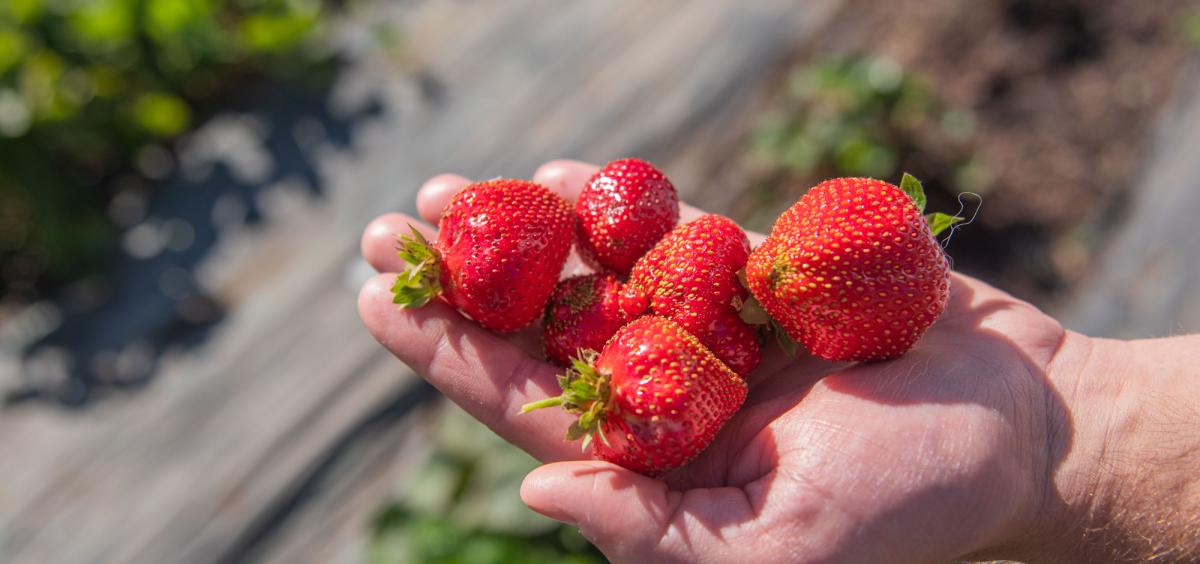
CORVALLIS, Ore. – Oregon is one of the best places to grow strawberries, and early spring is the time to plant new strawberry plants.
Gardeners in Oregon can choose from several flavorful cultivars, or varieties. If you plan it right, you can pick ripe fruit for your family through most of the growing season.
Strawberries fall into three categories, each with several varieties. June-bearers produce one crop per year, usually during June. Everbearers produce two crops per year, one in June and one in August. Day-neutrals produce an almost continuous crop from May through early fall.
Varieties typically grown in Oregon are June-bearers, which are ideal if large numbers of strawberries are needed at one time, such as for jam or freezing. June-bearers will have better quality and texture than everbearers or day-neutrals. For strawberries throughout the season, plant day-neutrals, which have better fruit quality than everbearers.
Strawberries are self-pollinating, so you don’t need to pair them with another variety to increase yield like you do with blueberries. Strawberries have better yield and larger fruit with increased pollination from bees, so keeping a bee-friendly garden is a good idea.
Once you’ve decided on the type of strawberry to grow, you’ll want to choose a variety. For June-bearing, there’s ‘Hood,’ which gives one good flush of berries in June and July and is the standard bearer for flavor. But most people will lean toward the day-neutral varieties. ‘Albion’ has large fruit and stores well for fresh eating. ‘Seascape,’ which thrives in Oregon, bears smaller fruit throughout the season. Readily available in the ever-bearing category is the older variety ‘Quinault,’ but its popularity is not what it was before better varieties arrived on the market.
More varieties are recommended in "Strawberry Cultivars for Western Oregon and Washington." There are a few suggested for colder areas, as well. Charts in the publication indicate when and how much the plant bears; type of berry and flavor; and susceptible diseases. For gardening at the beach check out "Growing Berries on the Oregon Coast: Strawberries."
Plant in full sun for best production. Build a raised bed 12 inches high by tilling in organic material, preferably compost, but anything is better than nothing.
There are two ways to plant strawberries – the matted-row and hill systems. Matted-row is preferred for June-bearers and hill for day-neutral and everbearers. To make a matted-row planting, place berries 12 to 15 inches apart in 2-foot-wide rows with beds 3 to 4 feet apart. The runners, which root and make new plants, will fill in the rest of the space and result in a dense planting. As the runners grow outside of the bed, push them back into the bed where they’ll make new plants.
In the hill system keep plants 12 to 15 inches apart alternating in double- or triple-wide rows. Aisles should be 1 ½ to 2 feet wide. Cut off all runners every two to three weeks. It’s best to wait until runners have formed “daughter” plants but have not rooted. This will give you one large plant in each spot instead of the daughters produced in the matted-row system.
Use a balanced fertilizer with the three numbers (percent nitrogen, phosphorus and potassium) on the front label equal or close to equal – 16-16-16, for example. Check the label and divide the overall amount recommended by the number of applications needed throughout the season. June-bearing strawberries get fertilizer following renovation after the fruit is finished. Everbearers and day-neutrals get several applications throughout the season. Refer to the above publication for more detailed instructions. Use a garden tool or broom to sweep fertilizer off leaves and always water after feeding.
Don’t be dismayed if strawberries don’t bear much the first year. Plants will produce a full crop the next year and two to four seasons after that before production dwindles. At that point, new plants will need to go in. Start a new patch in the year your existing one is in its last season so you don’t skip a year of fruit. Day-neutral strawberries, however, should only be kept for two years in Oregon and will produce a nice crop the first year. Remove the first two flushes of flowers to encourage a well-developed root system.
To get maximum yield, never let plants be stressed by lack of water. Keep newly set strawberries well irrigated with about 1 to 1½ inches of water a week. Don’t saturate the soil – strawberries dislike wet feet. Let the soil dry out to the touch (up to the first knuckle) before watering down to 6 to 8 inches. Strawberries don’t do well with weeds so if you irrigate properly the plant will grow stronger and outcompete the them.
Annual renovation is necessary for June-bearers but not day-neutral or everbearing. After June-bearers have finished producing berries, use a string trimmer or rotary mower and cut plants to about 2 inches above the crown. Remove the debris, but don’t rake vigorously or you’ll damage the crowns.
Strawberries are susceptible to verticillium wilt so it’s a good idea to rotate beds periodically, especially for day-neutrals. Spotted wing drosophila can be a pest; the best control is to keep your beds clean. Pick berries regularly, try to avoid a wet environment and keep runners pruned. The natural pesticide spinosad, sold under various brands, is one of the best treatments if they do get started on your fruit.
More information on growing strawberries is available in these OSU Extension publications:
About the OSU Extension Service: The Oregon State University Extension Service shares research-based knowledge with people and communities in Oregon’s 36 counties. OSU Extension addresses issues that matter to urban and rural Oregonians. OSU Extension’s partnerships and programs contribute to a healthy, prosperous and sustainable future for Oregon.
Kym Pokorny, 541-737-3380, [email protected]
Click photos to see a full-size version. Right click and save image to download.